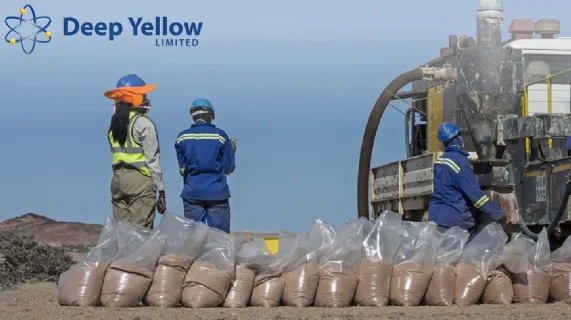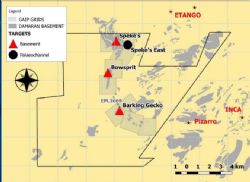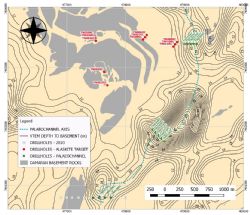
Scout Drilling Identifies New Mineralised Palaeochannel on Nova JV Project
Perth, Oct 12, 2017 AEST (ABN Newswire) - Deep Yellow Limited ( ASX:DYL) (
ASX:DYL) ( DYLLF:OTCMKTS) (Deep Yellow) is pleased to announce positive results from the early part of a 7,500m scout drilling program currently being carried out on its Nova Joint Venture project Namibia (the JV) where JOGMEC is earning a 39.5% interest. The overall drilling is designed to gain initial assessment of 10 alaskite and skarn associated basement targets and to test 3 newly identified palaeochannels that have been delineated within EPLs 3669 and 3670. This first-pass drilling campaign commenced 11 September on the Speke's group of targets located in the northern part of EPL3669 and, as of 10 October, 25 RC holes for 2,299m have been completed. Figure 1 (see link below) shows the general Nova JV tenement locations also with the EPL3669 prospect locations, Figure 2 (see link below) shows the drill-hole locations and Appendix 1 (see link below) lists all drill-hole information.
DYLLF:OTCMKTS) (Deep Yellow) is pleased to announce positive results from the early part of a 7,500m scout drilling program currently being carried out on its Nova Joint Venture project Namibia (the JV) where JOGMEC is earning a 39.5% interest. The overall drilling is designed to gain initial assessment of 10 alaskite and skarn associated basement targets and to test 3 newly identified palaeochannels that have been delineated within EPLs 3669 and 3670. This first-pass drilling campaign commenced 11 September on the Speke's group of targets located in the northern part of EPL3669 and, as of 10 October, 25 RC holes for 2,299m have been completed. Figure 1 (see link below) shows the general Nova JV tenement locations also with the EPL3669 prospect locations, Figure 2 (see link below) shows the drill-hole locations and Appendix 1 (see link below) lists all drill-hole information.
HIGHLIGHTS
- Early scout RC drilling on the Nova JV project identifies greater than 100ppm eU3O8 calcrete uranium mineralisation in a newly delineated palaeochannel.
- The mineralisation occurs in 3 adjacent holes with an average thickness of 3.5M grading 220ppm eU3O8.
- The mineralisation has no surface expression and is located in a previously unknown palaeochannel, only recently identified by geophysical surveys.
o this significantly upgrades regional prospectivity of the palaeochannels occurring in the project area.
- Additionally, 3 drill holes testing basement targets intersected narrow uranium mineralisation in skarn type lithologies.
Palaeochannel Target
The reinterpretation of a previously flown VTEM survey identified palaeochannels not known to exist on both of the tenements. These channels are essentially new discoveries not identifiable from the surface. Their geophysical similarities with other mineralised palaeochannels in the region indicated that they may contain calcrete type uranium mineralisation.
Three drill sections involving 14 holes for 639m were completed to test one of these newly identified palaeochannels. In the most northern section, drilling encountered uranium mineralisation in three adjacent holes (TN035 to TN037 - see Figure 2 in the link below). These averaged 220ppm eU3O8 over 3.5m between depths of 18 to 23m as determined by fully calibrated Auslog down-hole gamma logging unit. An historic hole (NTNR4) drilled in 2010 located 100m to the west, targeting basement mineralisation also showed uranium mineralisation, in cover sediments. The details are listed on Table 1 (see link below). Figure 3 (see link below) shows a cross-section of the holes drilled through the mineralised channel.
Basement Targets
Geophysical ground surveys carried out from May to August 2017 identified 10 targets in 4 areas showing potential for uranium mineralisation in the basement rocks of the JV tenements. A total of 11 RC holes for 1660m on 3 drill sections were completed on the Speke's basement targets to test for skarn type lithologies and whether these are associated with uranium.
Drilling intersected quartz-carbonate-pyrite veins cutting quartzo-feldspathic rocks. Narrow zones of elevated uranium are associated with the most pyritic vein intervals suggesting the discovery of a hitherto unknown type of hydrothermal uranium mineralisation. The equivalent uranium values as determined from the fully calibrated Auslog down-hole gamma logging unit are listed in Table 2 (see link below). There appears to be a correlation between elevated down-hole gamma counts, high pyrite content and high vein density indicating a hydrothermal nature of the uranium mineralisation in this area and this will be further investigated.
Conclusions
The indication that previously unexplored (and unknown) palaeochannels carry uranium mineralisation as identified in 3 adjoining holes at Speke's East is regarded as a very positive development. Although the two sections drilled 1.5km and 2.5km further to the south of this mineralisation did not encounter uranium mineralisation, the identification of calcrete associated mineralisation within the palaeochannels in the JV area is considered significant as this has expanded the prospectivity of the extensive palaeochannels which have now been defined to a considerable extent.
Up until now the possibility of uranium mineralisation in the JV tenements was conjecture, hypothesising on observations and results gained from the adjoining Reptile project and interpretation of new geophysical data. The discovery of the calcrete mineralisation at Speke's East has now validated this concept thus providing a legitimate exploration target, which the JV partners can pursue with confidence.
Ongoing Drilling
Drilling is continuing on this program with over 5,000m remaining to be completed. Another 7 basement targets will be tested in this current program plus a further 7 to 8 drill sections planned to test the newly identified prospective palaeochannels on EPLs 3669 and 3670.
To view tables and figures, please visit:
http://abnnewswire.net/lnk/C3TV0ULH
About Deep Yellow Limited
 Deep Yellow Limited (ASX:DYL) (OTCMKTS:DYLLF) is successfully progressing a dual-pillar growth strategy to establish a globally diversified, Tier-1 uranium company to produce 10+Mlb p.a.
Deep Yellow Limited (ASX:DYL) (OTCMKTS:DYLLF) is successfully progressing a dual-pillar growth strategy to establish a globally diversified, Tier-1 uranium company to produce 10+Mlb p.a.
The Company's portfolio contains the largest uranium resource base of any ASX-listed company and its projects provide geographic and development diversity. Deep Yellow is the only ASX company with two advanced projects - flagship Tumas, Namibia (Final Investment Decision expected in 1H/CY24) and MRP, Western Australia (advancing through revised DFS), both located in Tier-1 uranium jurisdictions.
Deep Yellow is well-positioned for further growth through development of its highly prospective exploration portfolio - ARP, Northern Territory and Omahola, Namibia with ongoing M&A focused on high-quality assets should opportunities arise that best fit the Company's strategy.
Led by a best-in-class team, who are proven uranium mine builders and operators, the Company is advancing its growth strategy at a time when the need for nuclear energy is becoming the only viable option in the mid-to-long term to provide baseload power supply and achieve zero emission targets.
Importantly, Deep Yellow is on track to becoming a reliable and long-term uranium producer, able to provide production optionality, security of supply and geographic diversity.
| ||
|











